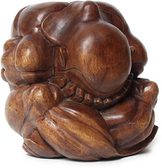
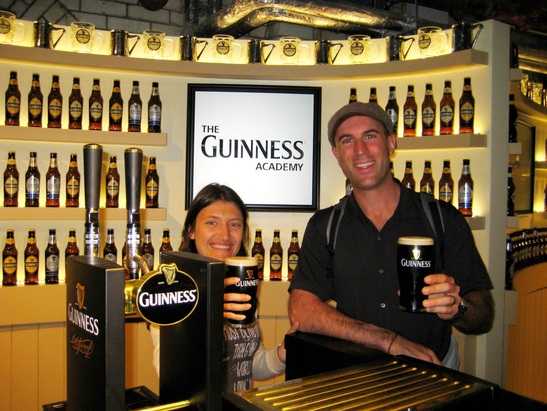
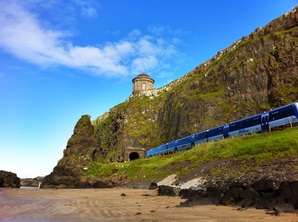
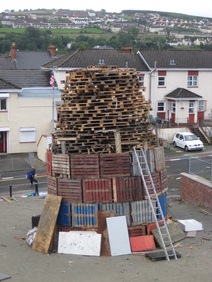
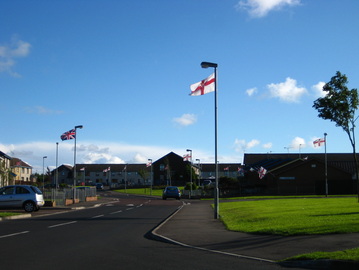
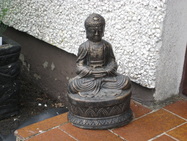
 The weeping Buddha is an iconic sculpture in Buddhist art. It is often carved by journeymen wood carvers from a single piece of wood to prove their mastery of the craft. Though there are various explanations as to its meaning, I have always believed that this weeping figure cries for the overwhelming suffering he sees in the world. It has always been a poignant image for me and it was on my mind as we traveled through Northern Ireland. But first things first - we traveled to Northern Ireland via a flight to Dublin. In our one day stopover, Jeff loaded up on passport pages at the US embassy and we spent a pleasant day at the Guinness Storehouse, a museum of Guinness brewing, history, and marketing. We also took a brief course in pouring the “perfect pint” and as luck would have it, some Jehovah’s Witnesses gave us their free beer tickets at the end of the tour…which almost made us miss our bus to Northern Ireland! 
Neda & Jeff learn to pour the perfect pint of Guinness...I learned that a draught of Guinness is infused with 80% nitrogen and 20% carbon dioxide at the tap - which is what gives it the creamy head and flavor. This wasn't invented until the 1950's, however, so before that a Guinness would be much more like a regular stout beer...
In the end some lucky tram timing got us into Londonderry (Derry according to some) on time. Northern Ireland, which is a separate country from the Republic of Ireland and is part of the UK, was a lesson in contrasts for us that can’t be understood without some brief history. It begins in earnest around the early 1600’s. A group of Irish earls fled the country (for reasons still debated) and their estates were quickly confiscated by the Crown. To secure the area for English (and Protestant rule), King James I (VI of Scotland) establishes a plantation scheme whereby the land is to be settled by low-land Scottish raiders living along the English border that he had banished for their crimes. James was tired of the constant border raids of these families and thought that he could solve two problems at once. He could force the migration of the raiders to relieve the troubles along the Scotland-England border while also spreading Protestantism and English rule to the predominantly Catholic population there. The raiders were joined by a plethora of other Scots and some English looking to flee harsh economic times in their countries.  Mussenden Temple near Derry Though the plantation system would eventually repress the native Catholics and lead to the loss of their land, it should be noted that the English Lord in charge of implementing the plantation, Arthur Chichester, thought that an equitable distribution of land to the native Irishmen and incoming Protestants would reconcile the locals to English rule. However, it only took one mishap to tip the scales towards inequality. One of the last remaining Irish earls named Cahir O’Doherty (who was actually an ally of the English in the 9 Years War) was punched in the face by the new governor of Derry George Paulet during an argument. This prompted O’Doherty to seek revenge by burning Derry and starting a rebellion. The rebellion was quashed and with it any chance for equitable distribution. Fearing the local population, King James ensured that Protestants received the lion’s share of the land, sowing dissent permanently into the native Irish population. This was compounded by the exile of all Catholic priests from the area in an attempt to convert the population to Protestantism. It is amazing how one punch can change the course of history. The plantation era in English-Ireland relations was not restricted to Ulster – if you are interested in more of the history you can read about it here. This oppressive situation continued until 1641 when the native Catholics staged another rebellion and brutally attacked the Protestant landowners and their families. This act of violence was met in kind by the enraged Protestants of Ulster and the cycle had begun. The next 400 years would be a continuing battle between protestants and Catholics, culminating in the late 1960’s with the beginning of what they call “The Troubles”. The troubles were a time of increased militant action between paramilitary groups like the Irish Republican Army (which wanted to see a united Ireland with no influence from the British Crown) and the loyalist Ulster Volunteer Force, who wished to defend their right to stay a part of the UK and to be Protestant ruled. After over 30 years of fighting, a truce was made with the Belfast agreement of 1998. Our experience was that while much of the paramilitary activity has subsided in Northern Ireland due to this truce, the tribal division between the two groups of people was still starkly evident.  Preparing the bonfire for 11th eve As we traveled through the North, various towns would be coated with either loyalist colors (the red, white, and blue of the United Kingdom Union Jack flag and the Flag of Ulster) or the nationalist colors of the Republic of Ireland (green, white, and orange). Even today, if boys living in a Protestant enclave near the center of Derry wander too far from their homes, they are swiftly given a beating by the Catholics surrounding them. We happened to be in the country on the 12th of July, a holiday where Protestants celebrate the victory of William of Orange over King James II at the Battle of the Boyne. This victory essentially sealed protestant rule over Northern Ireland. The evening of the 11th is marked by an enormous amount of massive bonfires lit by the Protestant population all over the country (we went to 3 alone in a little neighborhood outside Derry). The day of the 12th is then followed by talented marching bands touting the orange colors and Ulster Flag as they march through Catholic and Protestant neighborhoods, celebrating a victory that divided their country 400 years ago and left the native population as 2nd class citizens.  Partisan flags fly in most neighborhoods As I watched this parade, the image of the weeping Buddha was strong in my mind. I could see him crying at the terrible suffering that both sides of this battle had endured. Long ago this conflict stopped being about who is wrong and who is right as the vicious cycle of violence followed by revenge played out over and over. The hardcore Catholics side was unwilling to forget the way their land was occupied and accept that the Protestants are a legitimate part of their country now. The hardcore Protestants were terrified that a Catholic majority will lead to them becoming 2nd class citizens out of revenge. While the Belfast Agreement has led to non-violent power sharing for the last 15 years, the sectarian separation between the people of Northern Ireland has not abated. While all of this conflict and hatred can seem overwhelming, our experience in Northern Ireland was still defined by smiling Buddhas more so than weeping ones. Our friend Iain (who Neda had only met once before we came to see him in Derry) planned a whole 4 day itinerary for us while we were in his country. He and his family graciously invited us to stay in their home as we traveled to the geological wonders of the Giant’s Causeway and the Marble Arch Caves. Iain’s friend Alex took us on a wonderful tour of the city walls of Derry, fielded all my questions about the history of the region, and even served us a delicious high tea. Random folks at the pubs bought us pints of Guinness and welcomed us to their country. It was clear that the kindness of human nature was still shining through in Northern Ireland, despite the fog of division that rested over the country.  June's Smiling Buddha Nowhere has the contrasts in a country been so evident than during our visit to Northern Ireland. Nowhere have we seen such separation between people and yet nowhwere have we been given so much love. A warm thank you goes to June and John, Iain’s parents, who cooked wonderful meals for us, took us on hikes in the area, and shared their stories with us. See the wonderful pics of the sunny days we had at Giant’s Causeway, Mussenden temple, Carrick-a-Rede rope bridge and more here: http://flic.kr/s/aHsjAF5GrA
4 Comments
London is the largest city we visited during this part of the trip and it’s steeped in history and culture. A part of this history, the Tower of London stands along the River Thames and is a reminder of the militant past of Britain’s rulers. William the Conqueror built the core of the tower in 1078 when he invaded from Normandy and took over the British crown. The tower was originally erected to pacify the city’s population and establish his authority as King. While this bit of history is interesting, what really fascinated me was William’s changing identity. As a Norman he was a Frenchman, but his recent ancestry had come from Vikings who had invaded France years earlier. The French King Charles the Simple thought the best way to deal with this constant threat was to simply grant land titles to the invaders, thus creating new defenders of the territory (thus the name Normandy, from Norsemen or “North Men”). All of this history made us start to question identity in general. I always naively thought that the British Monarchy was an unbroken bloodline going back thousands of years when in fact just 1,000 years ago it was essentially taken over by Viking blood. Then, in 1714, George the Elector of Hanover became King, giving the crown the primarily German blood it retains even today (Queen Elizabeth comes from this line). 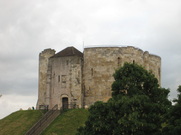 Clifford's Tower in York This inquiry into identity was heightened during our visit to York, when I saw that in York around 1190, my identity as a Jewish person would have seen me burned in Clifford’s Tower due to the capricious desires of a mob envious of perceived wealth and eager to wipe out their debts. These examples of how identity can be used to claim power over people’s lives (in the case of the Monarchy) or the right to claim another’s life (in the case of the Jews) proves what a destructive concept it can be. It is useful to define ourselves in relation to others for the purposes stimulating creative thought and giving us a lens to interpret the world. But we must recognize that this lens is simply a mental fabrication that our ego uses as it sees fit to get what it wants. With this understanding, we can start to be less attached to our identity. This doesn’t mean we don’t appreciate who we are, but it does mean that we don’t take that concept so seriously that it causes pain for others. In a more practical sense, it felt wonderful to appreciate a part of my identity and see my cousin Amanda and her husband Sean in York after nearly a year of seeing no family from my side. York contains the buried Viking city of Jorvik that came to be when the Vikings conquered York and lived there from 875 to 954. It also has ancient Roman walls, haunted pubs, and beautiful churches to explore. The rest of our trip to London (before York) brought us a wonderful day with our friends Jeff & Karen from Austin, a visit by Neda to ancient Stonehenge, and beautiful walks around the city as it prepares for the Olympics.
Windmills have been a part of Dutch life for around 1,000 years. A low-lying country rich in rippling winds, it makes sense that the windmill would thrive in the Netherlands. Prior to 1594, however, windmills had limited applications. This is because the circular motion of the windmill would translate only into circular movements of the corresponding gears – useful for milling and irrigation, but not for much else. But one man would change the face of windmills forever and in doing so, would launch an empire. 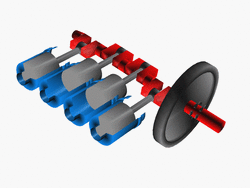 Crankshaft Cornelis Corneliszoon van Uitgees is described in the sparse texts we have about him as a simple farmer trying to support his family. But he had an idea. Corneliszoon reasoned that if you combined a simple crankshaft (pictured right) with the windmill’s engineering, you could convert the circular movements of the windmill into the back and forth motion needed to power a saw. In 1594, he built his first saw mill and immediately he could cut the same amount of wood in one day as it would take 50 men to cut in that same amount of time. 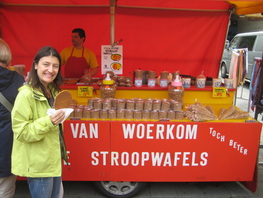 Another Dutch invention - stroopwaffles! This one innovation launched a huge construction boom at the shipbuilding yards as the Dutch suddenly had more processed wood than any other culture in the world. They constructed thousands of ships over the next 150 years and dominated global commerce as their empire spread across the globe. Who would have known that such a major change in the world could come from a seemingly small improvement to the windmill? It’s particular interesting to note that Corneliszoon didn’t invent either the windmill or the crankshaft. Like many inventors, he didn’t produce something entirely new so much as realize that two existing things could be combined to DO something entirely new. Neda and I have been interested in the delicate circumstances that must exist for someone to make a breakthrough of this type. For instance, all the technology needed to produce a steam engine existed during the Roman Empire, though the first workable steam engine wasn’t produced until the early 18th century. It took thousands of years until Thomas Newcomen figured out how to combine the technology in a way that worked. For us inspiration lies within the possibilities these stories suggest. What materials and ideas can be combined in our day and age to produce changes we never thought possible? From a spiritual perspective, does the key to your happiness not lie in something outside of yourself, but in just effectively combining the many tools you already have? It was these questions and more that journeyed with us as we explored the wonderful country of the Netherlands. We started with an anniversary weekend in Soest, a small town that houses the Soestdijk Palace as well as a working windmill. Our visit to the windmill and discussion with the millman there prompted the post above. We also went sailing with our CS host Max in the beautiful inlet to the North Sea created by the Zuiderzee Works, an engineering marvel by which the Dutch created "new land" in the early 20th century. 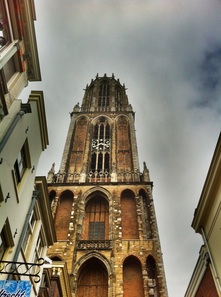 The Dom Tower before a rain From Soest, we traveled to Utrecht, a university town in the center of the Netherlands. For me it was a reunion of sorts, as this year marks the 10th sine I studied abroad at Utrecht University with several close friends from college. Though none of them could make it to Utrecht at the same time, we visited many of our old haunts (Café Belgie, the “Culture” Boat, ACU, the Dom tower, and of course, Mr. Jack’s). We also biked along the Oudegracht canal to Castle Zuylen, passing the canalboat red light district along the way. Special thanks to Catherine, our CS host for her company, restaurant recommendations, and for teaching us how to make homemade paneer! Utrecht led to our last city of the tour, Amsterdam. The cultural capital of the Netherlands is teeming with life. We met up with our traveling buddy Shea to explore the rambunctious streets of the canal lined city. Visits to the Van Gogh Museum and Anne Frank house were interspersed with delicious beers at Brouwerij’t IJ with our CS host Eran as well as visits to coffeeshops like De Dampkring, where Brad Pitt and George Clooney filmed Ocean’s 12. Old Memories mixed with new on this part of the trip, and just like Corneliszoon’s windmill, who knows what the new combination will create inside of us? For now we’ll have to wait and see as we prepare to jump across the channel and stage our own British Invasion! See pics of Soest and Utrecht here: http://flic.kr/s/aHsjAboB45 and pics of Amsterdam here: http://flic.kr/s/aHsjAbqUGd.
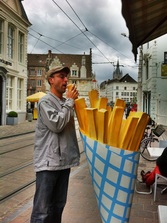 Ahhh Belgium – home of sumptuous chocolates, golden “frites” (french fries), and seemingly supersaturated beers! Our first stop in Brussels provided all 3 of these in quantities we could barely handle. Famous chocolatiers lined the streets and we delightfully sampled their wares piece by piece. Fries slathered in mayo and mustard sauces would provide the fuel to move us along to the local pub where the local abbey beers would lift our spirits, sporting typical alcohol percentages of 8-11%! In total, we sampled no less than 40 different Belgian brews in our 5 days here! 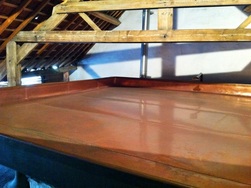 Cooling Tun Of particular fascination for Neda and me was a visit to the family run Cantillon Brewery in Brussels, the last brewery in the world to brew only traditional Lambic beers. Lambics are special because they are inoculated by a broad range of wild airborne fermenting agents in the open cooling tun in which they sit for just one night during the winter months. In that night, the sugary wort that was distilled from boiling wheat, malted barley (and later hops), sits in the cooling tun (pictured right) and attracts all manners of life to grow inside of it. The result is a slightly different beer with each batch. In just one Lambic batch brewed at Cantillon, organic chemists have found over 100 different strains of yeast, 27 strains of acetic acid bacteria, and 38 strains of lactic acid bacteria. By contrast, a typical commercial beer contains only one type of brewer’s yeast, which is added manually instead of by nature. This leads to a uniformity of taste and to limited health benefits (as we’ll see later). To top it off, nearly every beer in the world is pasteurized after production (to extend shelf life) thereby killing whatever live bacteria initially fermented it. 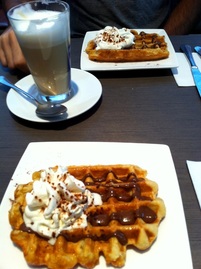 Belgium Waffles! While it might seem strange to seek out this “live beer” filled with bacteria and yeast, it is actually a tradition as old as time, and for good reason. Prior to modern brewing methods all beer was naturally fermented and the live organisms produced anaerobic (no air) environments inside the barrels that allowed the beer to stay preserved for years. But it's not just live beer that interests us – it's live food in general. Neda has been working on perfecting her sourdough bread recipe with wild bacteria. In this process, she mixes flour and water and catches live yeast from the fresh Bulgarian air by means of a temperature controlled “yeast catcher” her Dad made for us. Meanwhile, I made a mean batch of low salt sauerkraut that stays good for months not through the preservative of salt, but through the protection of the billions of probiotic bacteria living inside the jar. Nearly every culture has developed processes for creating live food, though their popularity has diminished in recent times. Neda and I are interested in studying the various forms and reintroducing them into our culture. Why you ask? Simply put, live foods support our health from the inside out. A fleet of about 100 trillion microorganisms called by scientists the “microbiome” support our health in a variety of ways. In fact, there are 10x more microbial cells in our body than cells containing human DNA, making the question of our identity a little tricky. Are we just the packaging for their lives? All these organisms work together (there are over 1000 different species and counting that have been identified in the microbiome) to synthesize the essential proteins and vitamins our body needs to survive. These “probiotics” (bacteria supporting our health) also combat the growth of bacteriods, harmful bacteria that produce ammonia and promote the growth of unhealthy fungi and yeasts in our gut. Essentially, live foods offering probiotics support our immune system, digestion, and a huge variety of other bodily functions. In this way, the beer at Cantillon could be considered the healthiest in the world because it packs a wallop of probiotics and the b-vitamins that they produce in each sip. We weren’t just literally "living it up" with probiotics in Belgium. We countered any health we acquired with live beer with an endless stream of non-live beers (essentially all beers other than Cantillon), beef stews, fries, and of course those perfectly refined chocolates! 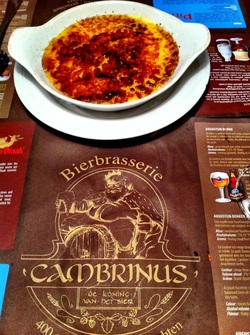 In between the decadence, we visited the famous Atomium (pictured above) - a sculpture of an iron crystal magnified 165 billion times and built for the 1958 World’s Fair. We learned about the dream for a unified Europe that arose out of WWII at the EU Parliament and we met many friends through couchsurfing. A special thanks to Maja for her hospitality, and to Annie, Collin, Ben and Christin for the homecooked dinner and homebrews! After Brussels, we headed to Gent, an ancient city highlighted by its magnificent skyline comprised of two churches and belfry. Our CS host Yola treated us like family as she took us on a tour of the city, its beers, its history, and its food! Finally, we ended our trip in Brugges, the romantic medieval city. The highlight for us there was a meal at Gambrinus restaurant (the legendary king of beer, said to have brewed the first lambic beers as described above), which served us Trappist cheese croquettes, beer braised rabbit, Flemish Carbonades prepared with “Gulden Draak” Beer, and Crème Brûlée perfumed with the dark Abbey beer Ename (pictured to the right). Now it’s our first day in the Netherlands in a little village called Soest. We are staying with some CS hosts who left us their home for the day because they had to work on their boat. They made us a little anniversary breakfast (it’s our 4 year anniversary today!) and now are enjoying some time together before moving on to Utrecht and Amsterdam! See all the pics of our great time in Belgium here: http://flic.kr/s/aHsjzZwKDE
As we traveled through Italy, it brought to mind for Neda & me how relatively “easy” it has been traveling through Bulgaria. Because Neda and her family speak Bulgarian as their native language, there is never really a miscommunication when dealing with others. With us only speaking a few word of Italian each, Italy was a completely different story. In San Miniato, the owner of our Bed & Breakfast, Anna, did not speak a single word of English. This led to many interesting “conversations” with Anna gesticulating, me pointing, and Neda frantically looking up words on her iPhone app. These experiences brought to mind for both of us how difficult it is to communicate clearly even when speaking the same language. Everyday life is full of these little frustrations where either you feel misunderstood or make someone else feel this way. Instead of getting frustrated with each other, perhaps the solution is to metaphorically act like we are all speaking different languages even while at home. The response in a foreign country is to patiently try to uncover what the other person is saying using any creative means available (miming, pointing, finding common words). Wouldn’t it be wonderful if when misunderstanding arises between two friends, partners, or even strangers in your native country, the same patience was applied? 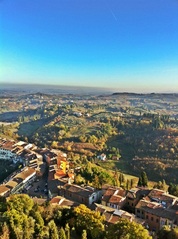 The view from San Miniato Despite some communication stumbles, we had no major falls on our “food tour” of Italy. San Miniato is a beautiful hilltop town overlooking Tuscan countryside. Our days consisted of waking up to a stunning view of the country in our little bed and breakfast before heading out on the cobblestone streets to peruse the numerous vendors lining the piazzas selling white truffles and products made with the white truffle. Lunch would be up at the top of the town, sitting with the Tower of Frederico while sharing a bottle of wine with truffle infused salami, porchetta, pecorino cheese, and chocolates. Dinner consisted of homemade tagliatelle (a pasta similar to linguini) topped with shredded truffles - delicious! 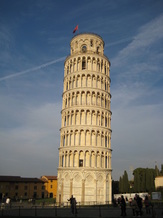 The Leaning Tower Next our travels brought us to Pisa, where we stared in wonder at the leaning tower, a building that took over two centuries to build before taking on its famous slant. We stayed with a local friend we met through couchsurfing.org and got to talk to him and his roommate about Italian politics (like the way the construction of fast train lines, called TAV, come at the cost of environmental destruction in Italy) and their involvement in an organization in Pisa that connects local farmers with urban residents directly to support local farming! 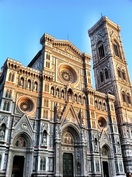 Duomo in Florence Our next stop was Florence, which brought the architectural wonders of the renaissance masters along with the gustatory delights of fresh gelato and pasta! We celebrated Neda’s birthday our first night in Florence in a little family restaurant where we enjoyed hearing the locals argue about the best regions to get prosciutto and truffles (few people are more passionate about their food than Italians). Now we are back in Bulgaria where the language sounds a little more familiar to me and a lot more familiar to Neda : ). But we hope to keep in mind the lessons of Italy, using patience when communicating with each other and realizing that words are only one aspect of how we can connect as people. The pictures from Bologna were posted in the previous post, but to see the pics from San Miniato, Pisa, and Florence, click here. To see selected photos with captions, view the slideshow below! Thanksgiving is explicitly a holiday of gratitude, of giving thanks for what we have. But for many (myself included) it is also a holiday of indulgence: in both eating and drinking. Given that our blog is called “Fields of Indulgence: World Travel & Spiritual Living”, perhaps we should examine the seeming contradiction of the ideas of “indulgence” and “spiritual living”. What is “indulgence” truly? Is it the greedy pursuit of sensual pleasure in excess of one’s needs? Is it giving yourself a little extra treat at the end of the day because you “deserve” it? These may capture the shadow of the idea, but they omit a key point: that to truly indulge one most do so fully and wholeheartedly - a task that is not always so easy. To indulge is to merge with the activity you are performing so that there is no separation between you and it. What is ironic is that when we finally get onto vacation or around the Thanksgiving table, we realize that we are often not really able to indulge. We may find ourselves stressed by family though we don’t understand why, anxious about how fast our vacation is going by, or feeling guilty for eating or drinking too much. 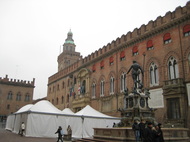 Piazza di Maggiore in Bologna Neda and I planned an impromptu trip to San Miniato, Italy for the Annual White Truffle Festival being held there this weekend. We flew into Bologna on Monday the 21st (after the plane was dramatically diverted from our original destination of Forli when the pilot tried to land and realized he couldn’t see the runway through the fog!) and have been “practicing indulgence” in this gastronomic paradise ever since. 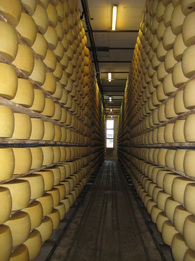 Aging Parmesian... We’ve wondered the streets of Bologna, taking in its architectural wonders while also taking in copious amounts of homemade pasta, salty-sweet gelato, and the region’s varied wines. We have gone out into the countryside of Modena to see local craftsmen preparing parmesan cheese and to see how small families produce limited batches of “Balsamic Vinegar di Modena” (only to then taste the vinegar with Ricotta that was freshly made an hour before at the Parmesan factory!). We saw how the famous proscuitto di parmais meticulously cured and dry aged, resulting in thin slices of buttery salt meat. Finally, on Thanksgiving itself, we sampled the region’s wild game with dishes of wild boar and rabbit. What has been interesting is that even while we have been practicing indulgence, we have noticed that we still find ourselves worrying about the money we are spending, about whether we are seeing enough, and other generalized anxieties that arise from traveling. These anxieties take us out of the present moment and into our own heads - alienating us from the experience lying right before us. It is at these times that we realize how truly challenging indulging can be. For to truly indulge, you must leave your baggage at the door so that you can be intimate with this present moment and fully experience it. And learning to leave our baggage behind, even for just a few moments, is a constant spiritual practice. 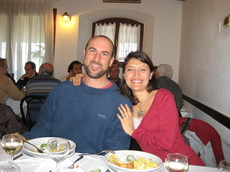 Thanksgiving Dinner in Modena So when you find yourself in an indulgent situation this holiday season and the inevitable distractions between you and moment creep in - – give yourself a mental break and allow yourself to connect to the experience. Really allow yourself to taste that piece of pumpkin pie without hurrying through to the next thing or thinking about something else as your eating it. If you have a friend, partner, or family member who can help gently and non-defensively point out when they see you disconnected from the moment and caught in unproductive thought patterns, even better. In this way your indulgences and your free time can become a spiritual practice for yourself and your family instead of just a license to excess. It’s time for Neda and I to continue working with this practice as we head to San Miniato to sample the sensuous and savory white truffles! Check out some highlights of this leg of the trip (with captions) in the slideshow below or see them all on snapfish here. Ciao from Italy! |